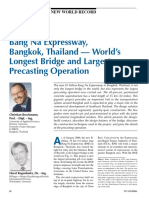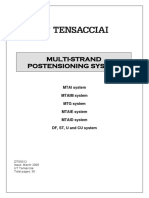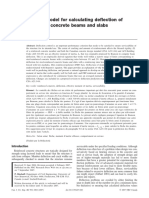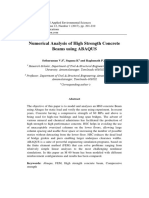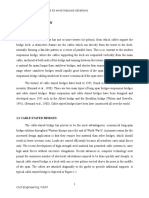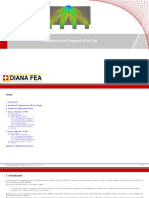0 ratings0% found this document useful (0 votes)
The Olympic Stadium in Munich, Germany
The Olympic Stadium in Munich, Germany
Uploaded by
kmarshalThe Olympic Stadium in Munich, Germany used a tensile structure designed by Frei Otto for the 1972 Olympics. The structure is composed of acrylic glass stabilized by steel cables in tension, symbolizing the Alps. This new tensile construction method uses lightweight materials like fiberglass, polyester, and steel cables to create flexible, non-traditional shapes not possible with standard construction materials. The steel cable structural system is complex, with a series of masts supporting cables holding the glass membrane in a repeating pattern across the stadium.
Copyright:
Attribution Non-Commercial (BY-NC)
Available Formats
Download as PDF, TXT or read online from Scribd
Download as pdf or txt
The Olympic Stadium in Munich, Germany
The Olympic Stadium in Munich, Germany
Uploaded by
kmarshal0 ratings0% found this document useful (0 votes)
The Olympic Stadium in Munich, Germany used a tensile structure designed by Frei Otto for the 1972 Olympics. The structure is composed of acrylic glass stabilized by steel cables in tension, symbolizing the Alps. This new tensile construction method uses lightweight materials like fiberglass, polyester, and steel cables to create flexible, non-traditional shapes not possible with standard construction materials. The steel cable structural system is complex, with a series of masts supporting cables holding the glass membrane in a repeating pattern across the stadium.
Original Title
New Layout 2
Copyright
© Attribution Non-Commercial (BY-NC)
Available Formats
PDF, TXT or read online from Scribd
Share this document
Did you find this document useful?
Is this content inappropriate?
The Olympic Stadium in Munich, Germany used a tensile structure designed by Frei Otto for the 1972 Olympics. The structure is composed of acrylic glass stabilized by steel cables in tension, symbolizing the Alps. This new tensile construction method uses lightweight materials like fiberglass, polyester, and steel cables to create flexible, non-traditional shapes not possible with standard construction materials. The steel cable structural system is complex, with a series of masts supporting cables holding the glass membrane in a repeating pattern across the stadium.
Copyright:
Attribution Non-Commercial (BY-NC)
Available Formats
Download as PDF, TXT or read online from Scribd
Download as pdf or txt
0 ratings0% found this document useful (0 votes)
The Olympic Stadium in Munich, Germany
The Olympic Stadium in Munich, Germany
Uploaded by
kmarshalThe Olympic Stadium in Munich, Germany used a tensile structure designed by Frei Otto for the 1972 Olympics. The structure is composed of acrylic glass stabilized by steel cables in tension, symbolizing the Alps. This new tensile construction method uses lightweight materials like fiberglass, polyester, and steel cables to create flexible, non-traditional shapes not possible with standard construction materials. The steel cable structural system is complex, with a series of masts supporting cables holding the glass membrane in a repeating pattern across the stadium.
Copyright:
Attribution Non-Commercial (BY-NC)
Available Formats
Download as PDF, TXT or read online from Scribd
Download as pdf or txt
You are on page 1/ 13
THE OLYMPIC STADIUM IN
TENSILE CONSTRUCTION MUNICH, GERMANY
OLYMPIAPARK
TENSILE CONSTRUCTION The Olympic Stadium in Munich, Gemany, done by the engineer
Frei Otto for the 1972 Olympics, is an example of a surface
stressed structure. This structure uses acrylic glass stablized by
steel cables that are in tension. The idea was to symbolize the
alps with its white transparent shield. This new form of structure
has opened up many new possibilities in the 20th and 21st cen-
turies with its flexibility for newshapes and forms that traditional
hard-surfaced materials cannot provide.
TENSILE CONSTRUCTION MEMBRANE MATERIALS:
Fiberglass, Polyester and Steel Cable
These materials enable a building to take on different forms
that traditional steel, masonry and wood construction do not
allow. The acrylic glass is cut and placed in tension within the
steel cables that are connected to steel masts which in turn are
secure to the ground. These materials working together cause
the structure to be in tension.
OLYMPIAPARK STRUCTURAL
TENSILE CONSTRUCTION SYSTEM
The steel structural system of the tension
cables is simple in theory, but very complex
when putting all of the components, such as the acrylic glass,
supporting masts, and joints,
together forming a holistic unit that is harmoniously in tension
and compression. In the
Olympic Stadium there are a series of masts
supporting steel cables, which hold the glass
in place. A repetition of these accross the
stadium forms a set pattern in which all of
the cableswork together. The cable must
change direction and be bolted together
before going directly to the membrane from
the steel mast. These steelbrackets give
the support needed for the cables to remain in tension, while
pulling
with the same amount of force needed
to attain the desired shape of the membrane
without causing too much stress.
STUDY MODEL
TENSILE CONSTRUCTION
In the first study model we used flower arrangment wire for our cables
and main support structure. We also used a thicker wire for the main
connection in the front of the section and hot glue for the connection
places. As for the material used to cover the section we used a stretch-
able mesh fabric and for the base we used instalation foam. All of these
materials worked well for beginning stages, but for the next study
model we decided to use stronger materials and a sturdier base.
TENSILE CONSTRUCTION STUDY MODEL
In our second study model we used a thicker steel pole for the structur-
al system. Large wooden rods made up the mast and small steel cable
made up the cables. Another thicker steel cable made up the main front
connection. We anchored everything into the plywood using eyehooks
and we drilled angled holes for the masts. These materials worked well
together, but the scale was not working well with the natural tension
and compression of the structure. Therefor for the final model we will
use thinner cables and a thicker main front connection for a more stable
support.
You might also like
- Operation Management MCQS: A) Production Management B) Finance Control100% (7)Operation Management MCQS: A) Production Management B) Finance Control19 pages
- Submitted By: Under The Guidance: Dr. K. AshaNo ratings yetSubmitted By: Under The Guidance: Dr. K. Asha23 pages
- What Is Pre-Stressed Concrete?: Concept of PrestressingNo ratings yetWhat Is Pre-Stressed Concrete?: Concept of Prestressing43 pages
- Historical Perspective On Prestressed ConcreteNo ratings yetHistorical Perspective On Prestressed Concrete17 pages
- Prestressing With Unbonded Internal or External TendonsNo ratings yetPrestressing With Unbonded Internal or External Tendons9 pages
- Analysis of Cracked Prestressed Concrete Sections - A Practical ApproachNo ratings yetAnalysis of Cracked Prestressed Concrete Sections - A Practical Approach12 pages
- Cable Suspended Roof Structureppt CompressNo ratings yetCable Suspended Roof Structureppt Compress12 pages
- Engineering Students Understand The Elastic Neutral Axis But What About The Plastic Neutral AxisNo ratings yetEngineering Students Understand The Elastic Neutral Axis But What About The Plastic Neutral Axis9 pages
- Modeling of Post-Tensioned Rocking Bridge ColumnsNo ratings yetModeling of Post-Tensioned Rocking Bridge Columns101 pages
- Rational Model For Calculating Deflection of Reinforced Concrete Beams and SlabsNo ratings yetRational Model For Calculating Deflection of Reinforced Concrete Beams and Slabs11 pages
- Numerical Analysis of High Strength Concrete Beams Using ABAQUSNo ratings yetNumerical Analysis of High Strength Concrete Beams Using ABAQUS10 pages
- Dsi Usa Dywidag Bonded Post Tensioning Systems Us PDFNo ratings yetDsi Usa Dywidag Bonded Post Tensioning Systems Us PDF32 pages
- Cable Stayed Bridges and Its Wind Induced VibrationsNo ratings yetCable Stayed Bridges and Its Wind Induced Vibrations34 pages
- Finite Element Modeling of RC Structures Strengthened With FRP Laminates (2001) - Report PDFNo ratings yetFinite Element Modeling of RC Structures Strengthened With FRP Laminates (2001) - Report PDF113 pages
- Behaviour of Beam-Column Joint Under Cyclic LoadingNo ratings yetBehaviour of Beam-Column Joint Under Cyclic Loading3 pages
- Toward A Consistent Design of Structural Concrete: Pci Journal May 1987No ratings yetToward A Consistent Design of Structural Concrete: Pci Journal May 198710 pages
- Parametric and Pushover Analyses On Integral Abutment BridgeNo ratings yetParametric and Pushover Analyses On Integral Abutment Bridge14 pages
- Advances in The Analysis of Simply Supported Concrete Bridge Deck PDFNo ratings yetAdvances in The Analysis of Simply Supported Concrete Bridge Deck PDF16 pages
- Seismic Behaviour and Analysis of Continuous Reinforced Concrete BridgesNo ratings yetSeismic Behaviour and Analysis of Continuous Reinforced Concrete Bridges356 pages
- Impact Response Spectrum For Vessel-Bridge CollisiNo ratings yetImpact Response Spectrum For Vessel-Bridge Collisi10 pages
- Beam-Columns: CE579 - Structural Stability and Design Amit H. Varma Ph. No. (765) 496 3419No ratings yetBeam-Columns: CE579 - Structural Stability and Design Amit H. Varma Ph. No. (765) 496 341917 pages
- Dynamic Analysis of Soil-Steel Railway Bridge Plaxis 2004No ratings yetDynamic Analysis of Soil-Steel Railway Bridge Plaxis 2004137 pages
- State-of-the-Art of Integral Abutment Bridges: Design and PracticeNo ratings yetState-of-the-Art of Integral Abutment Bridges: Design and Practice10 pages
- Dynamic Analysis of An Extradosed Bridge: International Journal of Advance Engineering and Research DevelopmentNo ratings yetDynamic Analysis of An Extradosed Bridge: International Journal of Advance Engineering and Research Development6 pages
- Analysis of Cable-Stayed Bridges During Construction by Cantilever MethodsNo ratings yetAnalysis of Cable-Stayed Bridges During Construction by Cantilever Methods18 pages
- Analysis of Hybrid Form of Cable Stayed and Suspension Bridge - A ReviewNo ratings yetAnalysis of Hybrid Form of Cable Stayed and Suspension Bridge - A Review4 pages
- The Influence of The Span-To-Depth Ratio in Designing Concrete BridgesNo ratings yetThe Influence of The Span-To-Depth Ratio in Designing Concrete Bridges231 pages
- Double Composite Bridges The Main Concept and Examples of Its ImplementationNo ratings yetDouble Composite Bridges The Main Concept and Examples of Its Implementation8 pages
- Elastic-Plastic Behavior of Steel Sheets Under In-Plane Cyclic Tension-Compression at Large StrainNo ratings yetElastic-Plastic Behavior of Steel Sheets Under In-Plane Cyclic Tension-Compression at Large Strain27 pages
- Study and Design of Anchorage Corner Blisters of Post-Tensioning TendonsNo ratings yetStudy and Design of Anchorage Corner Blisters of Post-Tensioning Tendons10 pages
- Preliminary Static Analysis of Suspension Bridges PDFNo ratings yetPreliminary Static Analysis of Suspension Bridges PDF8 pages
- VG0-Pap - (ASCE) - Shear Behaviour of Joints in Segmental BridgesNo ratings yetVG0-Pap - (ASCE) - Shear Behaviour of Joints in Segmental Bridges22 pages
- Seismic Behavior of Short Coupling Beams With Different Reinforcement LayoutsNo ratings yetSeismic Behavior of Short Coupling Beams With Different Reinforcement Layouts10 pages
- MinDOT Fatigue Detail Classification of Steel BridgesNo ratings yetMinDOT Fatigue Detail Classification of Steel Bridges191 pages
- Structural Engineering DocumentsFrom EverandStructural Engineering DocumentsJorge de BritoNo ratings yet
- A Catalogue of Details on Pre-Contract Schedules: Surgical Eye Centre of Excellence - KathFrom EverandA Catalogue of Details on Pre-Contract Schedules: Surgical Eye Centre of Excellence - KathNo ratings yet
- A Review Study On Effect of Steel Fibre and Marble Dust With Strength of Pavement Quality ConcreteNo ratings yetA Review Study On Effect of Steel Fibre and Marble Dust With Strength of Pavement Quality Concrete4 pages
- Quantity Calculations DILG Evacuation CenterNo ratings yetQuantity Calculations DILG Evacuation Center28 pages
- 3D Printed PEEK Carbon Fiber Composites PDFNo ratings yet3D Printed PEEK Carbon Fiber Composites PDF22 pages
- Bilal Hafiz Muhammad Supply Chain Management, Case Importing Footballs From PakistanNo ratings yetBilal Hafiz Muhammad Supply Chain Management, Case Importing Footballs From Pakistan41 pages
- Tilt-Up Concrete Association Guide Specifications in CSI Format Rev 2018 v1No ratings yetTilt-Up Concrete Association Guide Specifications in CSI Format Rev 2018 v118 pages
- 1991 TEXTO Concise Introduction To Ceramics PDF50% (2)1991 TEXTO Concise Introduction To Ceramics PDF164 pages
- Conveyor Chains For Demanding ApplicationsNo ratings yetConveyor Chains For Demanding Applications24 pages
- Download full Big Data Analytics Using Multiple Criteria Decision-Making Models 1st Edition Ramakrishnan Ramanathan ebook all chapters100% (1)Download full Big Data Analytics Using Multiple Criteria Decision-Making Models 1st Edition Ramakrishnan Ramanathan ebook all chapters55 pages
- FML Concretec Englisch Aktualisiert 130209 19458No ratings yetFML Concretec Englisch Aktualisiert 130209 1945830 pages
- Operation Management MCQS: A) Production Management B) Finance ControlOperation Management MCQS: A) Production Management B) Finance Control
- What Is Pre-Stressed Concrete?: Concept of PrestressingWhat Is Pre-Stressed Concrete?: Concept of Prestressing
- Prestressing With Unbonded Internal or External TendonsPrestressing With Unbonded Internal or External Tendons
- Analysis of Cracked Prestressed Concrete Sections - A Practical ApproachAnalysis of Cracked Prestressed Concrete Sections - A Practical Approach
- Engineering Students Understand The Elastic Neutral Axis But What About The Plastic Neutral AxisEngineering Students Understand The Elastic Neutral Axis But What About The Plastic Neutral Axis
- Rational Model For Calculating Deflection of Reinforced Concrete Beams and SlabsRational Model For Calculating Deflection of Reinforced Concrete Beams and Slabs
- Numerical Analysis of High Strength Concrete Beams Using ABAQUSNumerical Analysis of High Strength Concrete Beams Using ABAQUS
- Dsi Usa Dywidag Bonded Post Tensioning Systems Us PDFDsi Usa Dywidag Bonded Post Tensioning Systems Us PDF
- Cable Stayed Bridges and Its Wind Induced VibrationsCable Stayed Bridges and Its Wind Induced Vibrations
- Finite Element Modeling of RC Structures Strengthened With FRP Laminates (2001) - Report PDFFinite Element Modeling of RC Structures Strengthened With FRP Laminates (2001) - Report PDF
- Behaviour of Beam-Column Joint Under Cyclic LoadingBehaviour of Beam-Column Joint Under Cyclic Loading
- Toward A Consistent Design of Structural Concrete: Pci Journal May 1987Toward A Consistent Design of Structural Concrete: Pci Journal May 1987
- Parametric and Pushover Analyses On Integral Abutment BridgeParametric and Pushover Analyses On Integral Abutment Bridge
- Advances in The Analysis of Simply Supported Concrete Bridge Deck PDFAdvances in The Analysis of Simply Supported Concrete Bridge Deck PDF
- Seismic Behaviour and Analysis of Continuous Reinforced Concrete BridgesSeismic Behaviour and Analysis of Continuous Reinforced Concrete Bridges
- Impact Response Spectrum For Vessel-Bridge CollisiImpact Response Spectrum For Vessel-Bridge Collisi
- Beam-Columns: CE579 - Structural Stability and Design Amit H. Varma Ph. No. (765) 496 3419Beam-Columns: CE579 - Structural Stability and Design Amit H. Varma Ph. No. (765) 496 3419
- Dynamic Analysis of Soil-Steel Railway Bridge Plaxis 2004Dynamic Analysis of Soil-Steel Railway Bridge Plaxis 2004
- State-of-the-Art of Integral Abutment Bridges: Design and PracticeState-of-the-Art of Integral Abutment Bridges: Design and Practice
- Dynamic Analysis of An Extradosed Bridge: International Journal of Advance Engineering and Research DevelopmentDynamic Analysis of An Extradosed Bridge: International Journal of Advance Engineering and Research Development
- Analysis of Cable-Stayed Bridges During Construction by Cantilever MethodsAnalysis of Cable-Stayed Bridges During Construction by Cantilever Methods
- Analysis of Hybrid Form of Cable Stayed and Suspension Bridge - A ReviewAnalysis of Hybrid Form of Cable Stayed and Suspension Bridge - A Review
- The Influence of The Span-To-Depth Ratio in Designing Concrete BridgesThe Influence of The Span-To-Depth Ratio in Designing Concrete Bridges
- Double Composite Bridges The Main Concept and Examples of Its ImplementationDouble Composite Bridges The Main Concept and Examples of Its Implementation
- Elastic-Plastic Behavior of Steel Sheets Under In-Plane Cyclic Tension-Compression at Large StrainElastic-Plastic Behavior of Steel Sheets Under In-Plane Cyclic Tension-Compression at Large Strain
- Study and Design of Anchorage Corner Blisters of Post-Tensioning TendonsStudy and Design of Anchorage Corner Blisters of Post-Tensioning Tendons
- Preliminary Static Analysis of Suspension Bridges PDFPreliminary Static Analysis of Suspension Bridges PDF
- VG0-Pap - (ASCE) - Shear Behaviour of Joints in Segmental BridgesVG0-Pap - (ASCE) - Shear Behaviour of Joints in Segmental Bridges
- Seismic Behavior of Short Coupling Beams With Different Reinforcement LayoutsSeismic Behavior of Short Coupling Beams With Different Reinforcement Layouts
- MinDOT Fatigue Detail Classification of Steel BridgesMinDOT Fatigue Detail Classification of Steel Bridges
- A Catalogue of Details on Pre-Contract Schedules: Surgical Eye Centre of Excellence - KathFrom EverandA Catalogue of Details on Pre-Contract Schedules: Surgical Eye Centre of Excellence - Kath
- A Review Study On Effect of Steel Fibre and Marble Dust With Strength of Pavement Quality ConcreteA Review Study On Effect of Steel Fibre and Marble Dust With Strength of Pavement Quality Concrete
- Bilal Hafiz Muhammad Supply Chain Management, Case Importing Footballs From PakistanBilal Hafiz Muhammad Supply Chain Management, Case Importing Footballs From Pakistan
- Tilt-Up Concrete Association Guide Specifications in CSI Format Rev 2018 v1Tilt-Up Concrete Association Guide Specifications in CSI Format Rev 2018 v1
- Download full Big Data Analytics Using Multiple Criteria Decision-Making Models 1st Edition Ramakrishnan Ramanathan ebook all chaptersDownload full Big Data Analytics Using Multiple Criteria Decision-Making Models 1st Edition Ramakrishnan Ramanathan ebook all chapters








